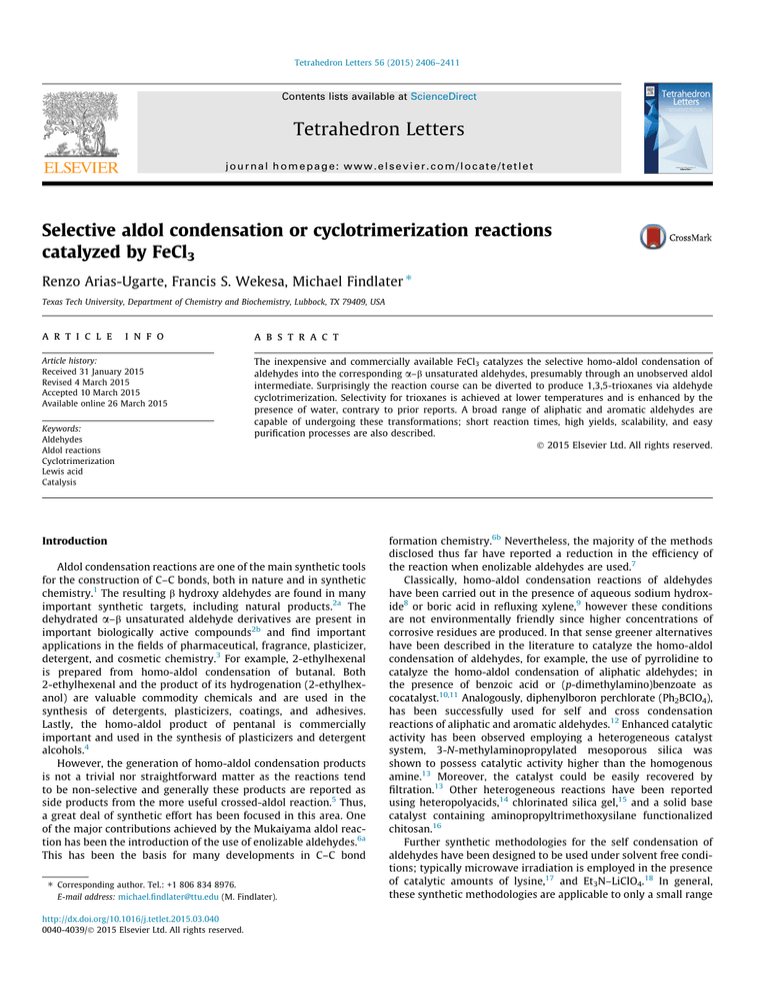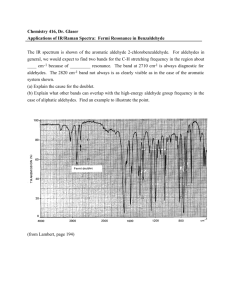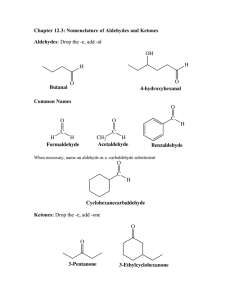
Tetrahedron Letters 56 (2015) 2406–2411
Contents lists available at ScienceDirect
Tetrahedron Letters
journal homepage: www.elsevier.com/locate/tetlet
Selective aldol condensation or cyclotrimerization reactions
catalyzed by FeCl3
Renzo Arias-Ugarte, Francis S. Wekesa, Michael Findlater ⇑
Texas Tech University, Department of Chemistry and Biochemistry, Lubbock, TX 79409, USA
a r t i c l e
i n f o
Article history:
Received 31 January 2015
Revised 4 March 2015
Accepted 10 March 2015
Available online 26 March 2015
Keywords:
Aldehydes
Aldol reactions
Cyclotrimerization
Lewis acid
Catalysis
a b s t r a c t
The inexpensive and commercially available FeCl3 catalyzes the selective homo-aldol condensation of
aldehydes into the corresponding a–b unsaturated aldehydes, presumably through an unobserved aldol
intermediate. Surprisingly the reaction course can be diverted to produce 1,3,5-trioxanes via aldehyde
cyclotrimerization. Selectivity for trioxanes is achieved at lower temperatures and is enhanced by the
presence of water, contrary to prior reports. A broad range of aliphatic and aromatic aldehydes are
capable of undergoing these transformations; short reaction times, high yields, scalability, and easy
purification processes are also described.
! 2015 Elsevier Ltd. All rights reserved.
Introduction
Aldol condensation reactions are one of the main synthetic tools
for the construction of C–C bonds, both in nature and in synthetic
chemistry.1 The resulting b hydroxy aldehydes are found in many
important synthetic targets, including natural products.2a The
dehydrated a–b unsaturated aldehyde derivatives are present in
important biologically active compounds2b and find important
applications in the fields of pharmaceutical, fragrance, plasticizer,
detergent, and cosmetic chemistry.3 For example, 2-ethylhexenal
is prepared from homo-aldol condensation of butanal. Both
2-ethylhexenal and the product of its hydrogenation (2-ethylhexanol) are valuable commodity chemicals and are used in the
synthesis of detergents, plasticizers, coatings, and adhesives.
Lastly, the homo-aldol product of pentanal is commercially
important and used in the synthesis of plasticizers and detergent
alcohols.4
However, the generation of homo-aldol condensation products
is not a trivial nor straightforward matter as the reactions tend
to be non-selective and generally these products are reported as
side products from the more useful crossed-aldol reaction.5 Thus,
a great deal of synthetic effort has been focused in this area. One
of the major contributions achieved by the Mukaiyama aldol reaction has been the introduction of the use of enolizable aldehydes.6a
This has been the basis for many developments in C–C bond
⇑ Corresponding author. Tel.: +1 806 834 8976.
E-mail address: michael.findlater@ttu.edu (M. Findlater).
http://dx.doi.org/10.1016/j.tetlet.2015.03.040
0040-4039/! 2015 Elsevier Ltd. All rights reserved.
formation chemistry.6b Nevertheless, the majority of the methods
disclosed thus far have reported a reduction in the efficiency of
the reaction when enolizable aldehydes are used.7
Classically, homo-aldol condensation reactions of aldehydes
have been carried out in the presence of aqueous sodium hydroxide8 or boric acid in refluxing xylene,9 however these conditions
are not environmentally friendly since higher concentrations of
corrosive residues are produced. In that sense greener alternatives
have been described in the literature to catalyze the homo-aldol
condensation of aldehydes, for example, the use of pyrrolidine to
catalyze the homo-aldol condensation of aliphatic aldehydes; in
the presence of benzoic acid or (p-dimethylamino)benzoate as
cocatalyst.10,11 Analogously, diphenylboron perchlorate (Ph2BClO4),
has been successfully used for self and cross condensation
reactions of aliphatic and aromatic aldehydes.12 Enhanced catalytic
activity has been observed employing a heterogeneous catalyst
system, 3-N-methylaminopropylated mesoporous silica was
shown to possess catalytic activity higher than the homogenous
amine.13 Moreover, the catalyst could be easily recovered by
filtration.13 Other heterogeneous reactions have been reported
using heteropolyacids,14 chlorinated silica gel,15 and a solid base
catalyst containing aminopropyltrimethoxysilane functionalized
chitosan.16
Further synthetic methodologies for the self condensation of
aldehydes have been designed to be used under solvent free conditions; typically microwave irradiation is employed in the presence
of catalytic amounts of lysine,17 and Et3N–LiClO4.18 In general,
these synthetic methodologies are applicable to only a small range






